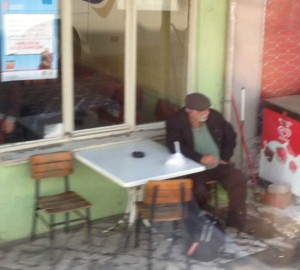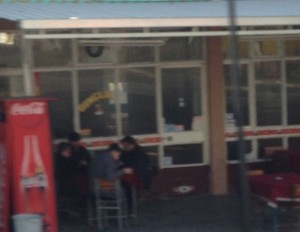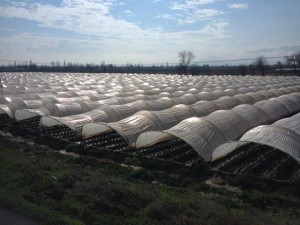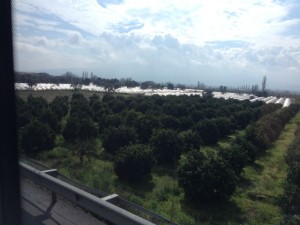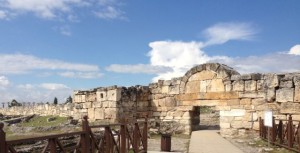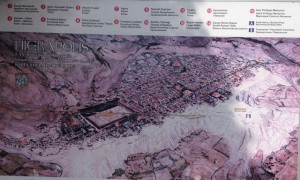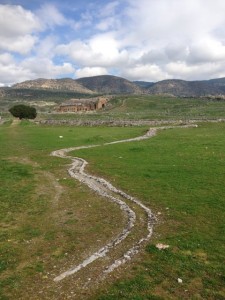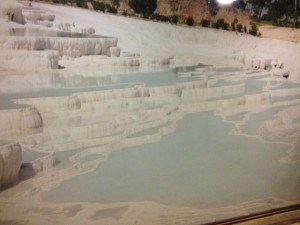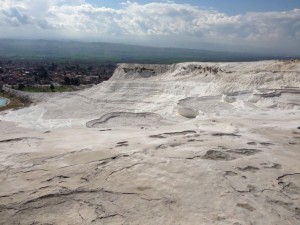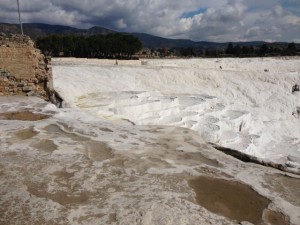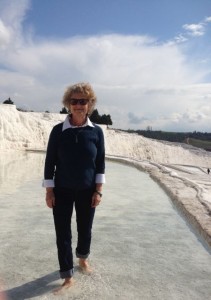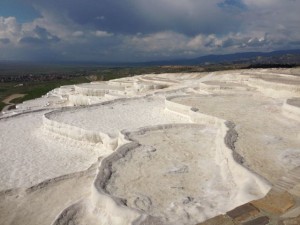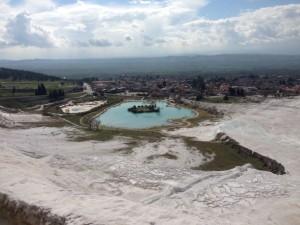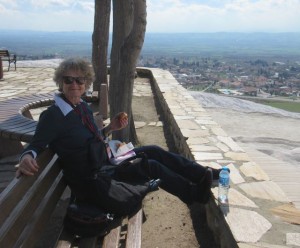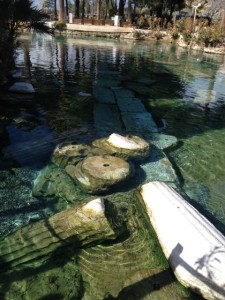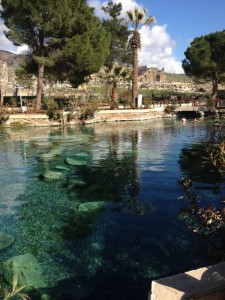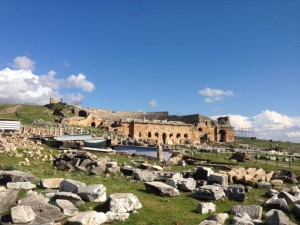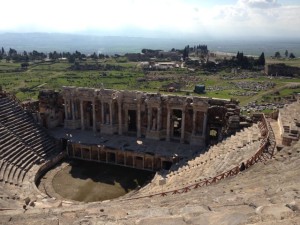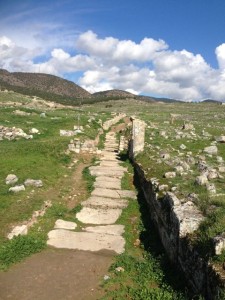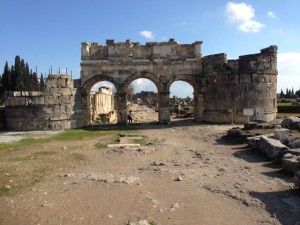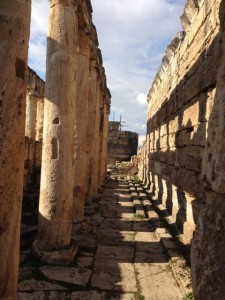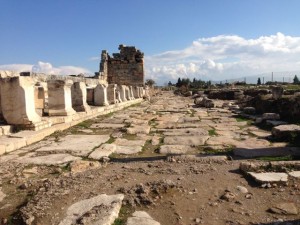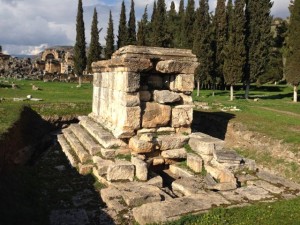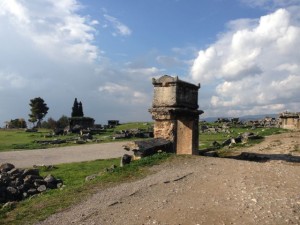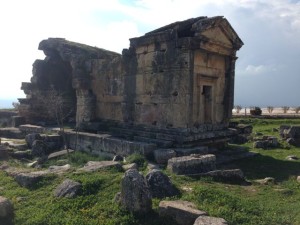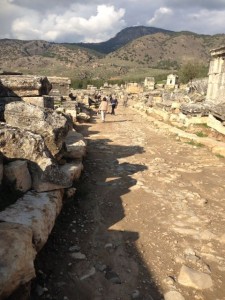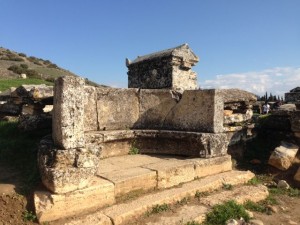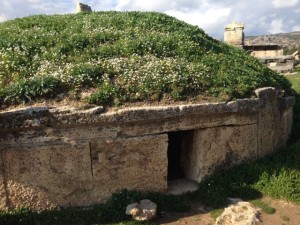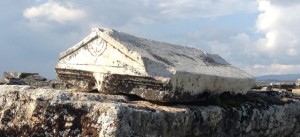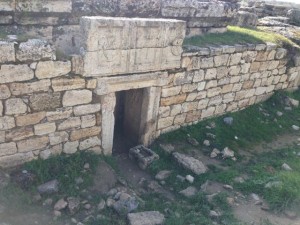Today we drive to Pamukkale hot springs. As we drive through small towns, we pass cafes with men gathered around small tables, most wearing gray or blue jackets and many with hats or caps. No women in sight.
We drive through a long valley of farmland, olive groves, orange trees, and tobacco greenhouses.
The small towns we pass through have shops filled with crates of oranges and huge jars of olives. I also notice that the olives are trimmed back each year, leaving massive trunks, I imagine so that the fruit will be easy to reach.
One thing that has surprised me is the amount of trash everywhere. Coming down Mt Ida yesterday, the creek beds were lined with bottles and plastic bags, as are most roads. It is a land of such natural beauty but there seems to be no environmental consciousness. They keep their cars spotless but the land is a trashcan, which must say something about lack of garbage collection services.
On the long bus rides between our destinations (today we have a 3hr drive), I have been glad to have audiobooks downloaded from the library onto my Ipad. It allows me to keep my eyes on the scenery but also makes the time pass more quickly. Each seat in the bus is equipped with a USB port, so we can charge cell phones, cameras, etc, and although we were told there was wireless, it has yet to work. The hotels all offer free wireless, which is all I have needed. I was glad I brought electricity adaptors, however, because the rooms do not provide them. I would strongly recommend both the adaptors and the audio books.
The central ancient city beside the thermal springs was Laodicea (of Book of Revelations). Pamukkale means cotton castle in Turkish for the white hillside formed by mineral-rich water cascading over the mountain for centuries and leaving behind deposits of calcium.
Hieropolis was supposedly settled by people fleeing Troy after the Trojan war. There are several explanations for the name Hieropolis: one is from Hera (city of Hera). Hera was queen of the Amazon who came to aid the Trojans during the war. Another explanation is that it comes from hydra (water). Certainly this area has always been known for its thermal springs.
In the fifth century BC, the Frygians carved courses in the rock to channel the water where they wanted it. The Persians followed, but nothing remains from that period.
The sad thing about the Pamukkale hot springs is that there is no longer water falling over the pools, so rather than being thermal pools, they are largely dry pools.
The culprit is apparently the many hotels that have been built to accommodate the tourists who flock to this Unesco World Heritage Site. They drain the water, which no longer flows over what were thermal pools.
The Romans made Hieropolis into a spa center. At its height, Hieropolis probably held 25,000 people, but because it was a spa town, many were visitors. The area is prone to earthquakes so many of the buildings have been damaged or fallen. The ancient pools, still open, hold Roman columns that must have once supported a roof.
The theater above the Roman baths held 8,000.
After the Roman period came the Byzantine (Christian) period. St Phillip is said to have died in Hieropolis.
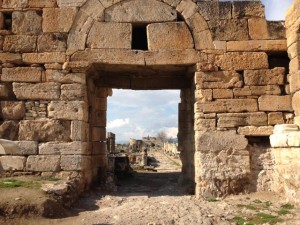 The Byzentine north gate is well inside the Roman gate, indicating that the city shrunk in size or perhaps the necropolis (graveyard) expanded.
The Byzentine north gate is well inside the Roman gate, indicating that the city shrunk in size or perhaps the necropolis (graveyard) expanded.
Just inside the Roman gate is the public latrine. Like in Ephesus, a fountain graced this latrine (seats missing) that accommodated several dozen Romans.
The Roman road between the two gates was a two way street with chariots driving on the left so that they would have their right arm free to wield their swords. You can see the ruts carved in the stone from the chariot wheels. As with all Roman roads, the water supply ran directly under the center of the road, which was paved with larger stones that could be removed if repairs needed to be made.
There has been a necropolis outside the city walls since people lived here. In the earliest times, bodies were left outdoors to be stripped of flesh by buzzards; then the bones were buried under the house (with person’s wealth—jewelry, pots, cups). In the Bronze age, they started making coffins out of terracotta pots that could hold bones of 5-6 people. Romans realized marble made body rot more quickly. Sarco and fagus mean flesh eater. Because many wealthy Romans died here, it became the second largest cemetery in the Roman Empire and Asia Minor.
Several different burial styles exist in the necropolis. Romans believed in life after death and they buried their dead with their possessions, which they might need in the afterlife. Some tombs were simply columns on which the sarcophagus was placed.
Others were made to look like houses with a door to interior.
There were benches placed along the road through the necropolis, supposedly to rest and commune with the dead.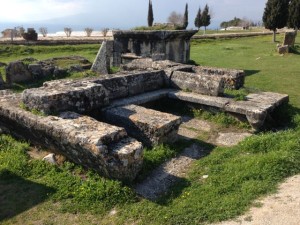
Frygians copied pyramids, building mound tombs, called tumulus. Some Romans imitated this style in their tombs.
Many sarcophagus were reused. This one shows a Roman lion below and a Jewish menorah above.
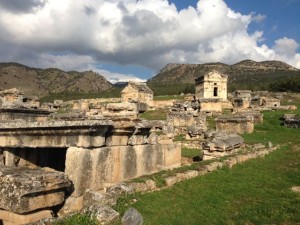 Twelve hundred sarcophagus have been identified, but thousands are still buried beneath the soil that comes down the mountain with heavy rains.
Twelve hundred sarcophagus have been identified, but thousands are still buried beneath the soil that comes down the mountain with heavy rains.
This tomb was for gladiators. The designs above the door are a shield, a trident, and an amphora.
Once again, we lucked out with weather. It rained while we were on our way to Pamakkule, but once we arrived, it was sunny, warm, and beautiful walking weather. Ellie’s fit bit tells us we walked almost six miles today and climbed 28 flights of stairs.
At our hotel, the Spa Hotel Colossae Thermal, Ellie and I took advantage of the thermal spa, soaking in a thermal pool for twenty minutes before dinner. Unfortunately, that makes us part of the problem that is draining the water from the mountain. The dinning room was filled with tourists from all over the world, and six tour buses were lined up in front of the hotel as we went to breakfast the next morning.




